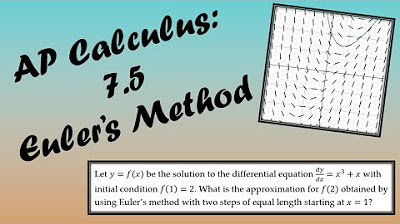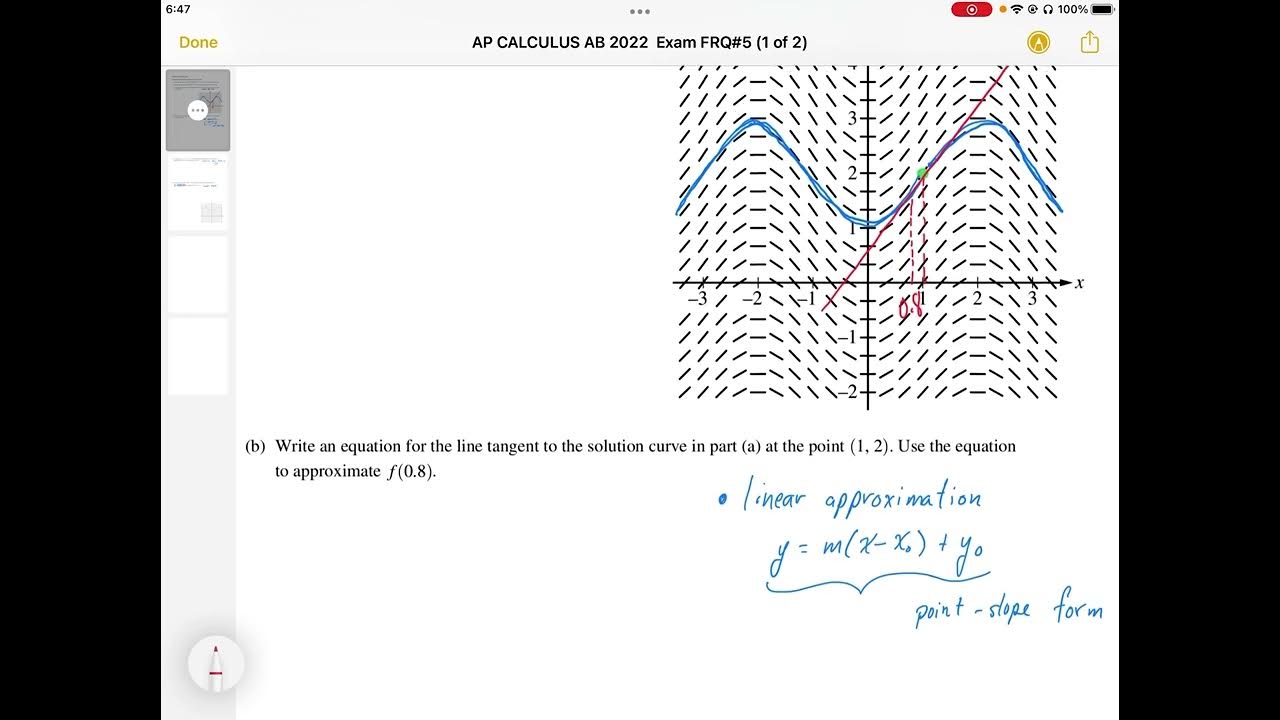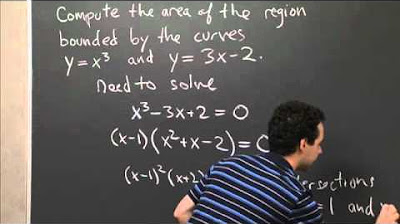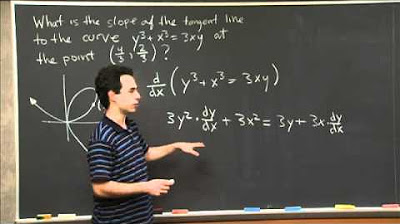Linear approx. with differentials | MIT 18.01SC Single Variable Calculus, Fall 2010
TLDRIn this recitation, the professor introduces the concept of linear approximation using differentials. The focus is on approximating the square root of 21 by evaluating the function f(x) = √(10x - x^2) at x=3, using a linear approximation at x=2 where f(2) = 4. The method involves calculating the differential dy, which is the change in y for a small change in x (dx=1). Through differentiation and applying the differential at x=2, the professor demonstrates how to find dy and use it to approximate the square root of 21, resulting in a straightforward and insightful approach to the problem.
Takeaways
- 📚 The class is focused on the concept of differentials and their application in linear approximation.
- 🔍 The students are tasked with approximating the square root of 21 using the function f(x) = √(10x - x^2) at the point x = 2.
- 📈 The function f(x) is chosen because it equals the square root of 21 at x = 3, which is the value we want to approximate.
- 📝 The method of differentials is introduced as an alternative language to derivatives for computing linear approximations.
- 📉 The general formula for linear approximation using differentials is f(x + dx) ≈ y + dy.
- 📌 The point of interest for approximation is x = 3, and the base point for the approximation is x = 2, with dx = 1.
- 🧩 To find dy, the differential of the function, we take the derivative of the outer function and multiply by the derivative of the inner function.
- 🔢 The derivative of the outer function (square root) is 1 / (2√(10x - x^2)), and the derivative of the inner function is (10 - 2x).
- 📐 At x = 2, the differential calculation simplifies to (1/2) * (16^(-1/2)) * (6), resulting in a dy value of 3/4.
- 📈 The final linear approximation for the square root of 21 is obtained by adding dy to the function value at x = 2, which is 4 + 3/4.
- 💡 The differential method provides a straightforward approach to linear approximation, offering a clear and alternative perspective to the traditional derivative-based method.
Q & A
What is the main topic of the recitation session?
-The main topic of the recitation session is the use of differentials to perform linear approximation, specifically to approximate the square root of 21 using a function based at the point x=2.
Why is the function f(x) = √(10x - x^2) used for this approximation?
-The function f(x) = √(10x - x^2) is used because its value at x=3 is exactly equal to the square root of 21, which is the value we want to approximate.
What is the purpose of using differentials in this context?
-The purpose of using differentials is to provide an alternative language to compute the same things that can be done with derivatives, making the process of linear approximation more straightforward in some cases.
What is the linear approximation formula in terms of differentials?
-The linear approximation formula in terms of differentials is f(x + dx) ≈ y + dy, where y = f(x) and dx is a small change in x.
What is the value of x at which the function is approximated in this problem?
-The function is approximated at x=3, but the linear approximation is based at x=2.
What is the value of dx for this approximation?
-The value of dx for this approximation is 1, as we are moving from x=2 to x=3.
How is dy calculated in the context of this problem?
-dy is calculated by taking the differential of the function, which involves taking the derivative of the outer function and multiplying it by the derivative of the inner function, then simplifying with the given values of x and dx.
What is the derivative of the outer function √(10x - x^2)?
-The derivative of the outer function √(10x - x^2) is (1/2) * (10x - x^2)^(-1/2).
What is the derivative of the inner function 10x - 2x^2?
-The derivative of the inner function 10x - 2x^2 is 10 - 4x.
What is the final linear approximation for the square root of 21 using the differential method?
-The final linear approximation for the square root of 21 using the differential method is 4 + 3/4, which simplifies to 7/4 or 1.75.
Why might using differentials seem more straightforward for some people?
-Using differentials might seem more straightforward because it provides a clear and direct way to calculate the change in the function value (dy) based on a small change in the input variable (dx), without having to deal with the complexities of the function itself.
Outlines
📚 Introduction to Linear Approximation with Differentials
The professor begins with a warm welcome and a discussion on differentials as an alternative language to derivatives for solving problems. The focus is on linear approximation, specifically using the function f(x) = √(10x - x^2) to approximate the square root of 21. The function is chosen because it equals the square root of 21 at x=3, and a linear approximation at x=2 is proposed to estimate the function's value at x=3. The students are encouraged to work on this problem and return for a collaborative solution.
🔍 Calculating the Differential for Linear Approximation
In this segment, the professor explains the method of differentials for linear approximation. The general formula for this method is presented, where the change in y (dy) is approximated as the function value at a nearby point (f(x+dx) ≈ y + dy). The specific case involves the function f(x) at x=2, with a change in x (dx) of 1, aiming to find the corresponding change in y (dy). The differential is calculated by taking the derivative of the function and multiplying it by dx. The derivative of the outer function (square root) is combined with the derivative of the inner function (10 - 2x), and the calculation is simplified by substituting x=2 and dx=1, resulting in a dy of 3/4. This value is then used to approximate the function's value at x=3 as 4 + 3/4, demonstrating the linear approximation using differentials.
Mindmap
Keywords
💡Differentials
💡Derivatives
💡Linear Approximation
💡Square Root
💡Function
💡Approximation
💡Change in Y (Δy)
💡Differential of a Function
💡Derivative
💡dx
💡1/2 Power
Highlights
Introduction to using differentials as an alternative language for computing derivatives.
Demonstration of linear approximation using differentials.
Task to approximate the square root of 21 using a linear approximation of the function f(x) = √(10x - x^2) at x=2.
Explanation of choosing the function f(x) for approximating √21 due to its value at x=3 being exactly √21.
The concept of using linear approximation at x=2 to estimate the function value at x=3.
General formula for linear approximation in terms of differentials: f(x + dx) ≈ y + dy.
Identification of the point of interest: x=2, y=4, and dx=1 for the approximation at x=3.
Calculation of dy as the differential of the function √(10x - x^2).
Derivation of the differential formula involving the derivative of the inner function (10 - 2x).
Substitution of x=2 and dx=1 into the differential formula to find dy.
Computation of dy as 3/4 using the values at x=2.
Final linear approximation result: f(3) ≈ 4 + 3/4.
Comparison of the differential method to other methods, highlighting its straightforwardness.
Conclusion that the differential method provides the same approximation as other methods.
Emphasis on the educational value of the differential approach for understanding approximations.
Transcripts
Browse More Related Video

AP Calculus BC Lesson 7.5

AP CALCULUS AB 2022 Exam Full Solution FRQ#5(a,b)

Area Between y=x^3 and y=3x-2 | MIT 18.01SC Single Variable Calculus, Fall 2010

Derivative of absolute value function

Euler's Method Differential Equations, Examples, Numerical Methods, Calculus

Implicit Differentiation | MIT 18.01SC Single Variable Calculus, Fall 2010
5.0 / 5 (0 votes)
Thanks for rating: